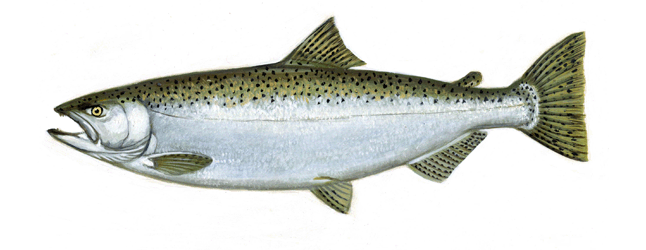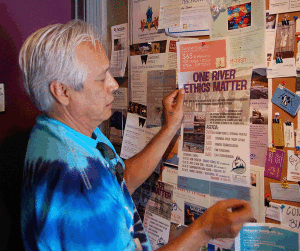
By Leslie Savage
Salmon in the Columbia River. Impossible?
Not so, says Virgil Seymour. Virgil, a Sinixt from Colville, along with the the Upper Columbia United Tribes (UCUT) and environmental organizations in the USA, is lobbying governments in Canada and the US to include Eco-system Function and Salmon Rehabilitation in the renewal of the Columbia River Treaty.
Mark your calendar for June 25 at the United Church at 7 pm. Posters around town give data — the evening will include a showing of the film titled Treaty Talks, by Adam Wicks-Arshak, about a canoe trip up the whole length of the Columbia River, from Portland to Columbia Lake.
Treaty news seems to have centred on 2014, and many people think it’s now a done deal. Not so. Both parties — Canada and the USA — now have until 2024to come up with changes, or to withdraw from the treaty altogether.
This is an issue that appeals to both fishers and hunters and to environmentalists. Various technologies exist for bringing fish back into the Columbia River — including a huge water cannon that would shoot the fish up and over the dams. Those details will be left until later, but in the meantime, we need to get the BC government on board.
The Washington State Department has now approved the Eco-Function as a third goal of the treaty signing — the first two being hydro-electric power generation and flood control. Adding Eco-system Function could make a difference to how the flood plains are treated, and how the whole system might work.
Virgil has also been participating in the Revelstoke Board of Education’s Aboriginal Committee events aimed at establishing an Aboriginal Friendship Society in Revelstoke. Approximately 10% of students in Revelstoke have self-identified as people with aboriginal or Metis ancestry, but there is no reserve nearby which would provide a focus for social and cultural events and knowledge.
The Sinixt (written Sin-Aikst in Colville, where they call themselves Lakes, or Arrow Lakes Indians) were the first nation who lived, fished and hunted in the territory from Kettle Falls (now a town, used to be an actual huge falls) in the USA to about where the Mica Dam is now located.
We need to understand the differences in the word “territory” between Euro-Canadian and indigenous cultural meanings. Canada is divided up into provinces, counties, lots, Crown Land and privately owned farms, city lots, and corporate-rights ownership — as well as aboriginal reserves. The surveyors mark specific lines across the land as divisions.
However, in aboriginal cultures, the land traditionally was seen more as a gift from the Creator to all creatures, animal and human, and land included in the Sinixt notion of territory was, originally, used to refer not just to where people lived—as nomadic or semi-nomadic peoples changed this relatively often — but to the regions that sustained them through hunting, trapping and fishing. In this sense, although most of the discovered pit house locations representing past habitation by Sinixt ancestors are along the Arrow Lakes, Slocan River, and Columbia River south of the confluence with the Kootenay River, the territory around Revelstoke was indeed the hunting and fishing territory of the Sinixt, with incursions from other groups.
That’s why Virgil Seymour thinks it’s right to lobby in Revelstoke for additions to the treaty process that would bring the salmon back. “It was our people who were here,” he says. “Sure, there were others, including Europeans starting in the early 1800s. But this was Sinixt territory.”
So come to “One River : Ethics Matter,” and watch Treaty Talks, hear some drums, and find out just how UCUT and other groups have gained the support of Washington State. The evening will end with Q and A about how we might encourage the BC Government to join this move to bring the salmon back to the Columbia.
Dates for One River: Ethics Matter
June 22, 2015: Grand Forks, BC. GEM Theatre
June 23, 2015: Nelson, BC, Rod and Gun Club.
June 24, 2015: Nakusp, BC, Bonnington Arts Centre
June 25, 2015: Revelstoke, BC, United Church on MacKenzie Avenue.



